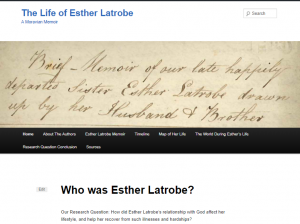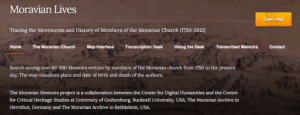To begin, this was a long and interesting journey in making the Esther Latrobe memoir into many things like the transcription, the timeline, a story map and etc. All of these things that the class did was pretty unique and once in a lifetime experience. However, there were some difficulties in making this all happen. An example can be on the first time the whole class started doing transcriptions on the memoir they all received, and how most of our pages were so blurry that no know could transcribe it. Luckily we had a person named Lorraine Parsons who is a Librarian and Archivist at Church House at the London Headquarters of the Moravian Church in the British Province. She was able to get high quality pictures of Esther Latrobe memoir in a matter of days, which were really clear to see.
 To begin, in doing our website, my group wanted something appeal to the eye when visiting the site itself. In order to that we had to come has a group to see what fits to our style and to theme of our memoir. We played around with the website for a bit and tried to see how everything worked for all us, but in choosing our theme to our website in the first day of this assignment the website did not work properly at all. Luckily we had the help Carrie every time we needed help with technology. Once the website problem was finally fixed (which was to get a new theme for the website) we had game plan in what had to do for it. Each member of our team was dedicated to a specific part of the website. One of the task was to included a summary so people could get some background information on Esther’s life and to add our research question and conclusions so people who visited our site would be able understand what our main objective was throughout the whole semester. Each member of my team did amazing in their part in making the website beautiful for many people to see for the future. Also, having the the opinions from other people that are not from our group were essential to have because even as a group we can make mistakes as a whole in our website and one doesn’t realize that there is one.
To begin, in doing our website, my group wanted something appeal to the eye when visiting the site itself. In order to that we had to come has a group to see what fits to our style and to theme of our memoir. We played around with the website for a bit and tried to see how everything worked for all us, but in choosing our theme to our website in the first day of this assignment the website did not work properly at all. Luckily we had the help Carrie every time we needed help with technology. Once the website problem was finally fixed (which was to get a new theme for the website) we had game plan in what had to do for it. Each member of our team was dedicated to a specific part of the website. One of the task was to included a summary so people could get some background information on Esther’s life and to add our research question and conclusions so people who visited our site would be able understand what our main objective was throughout the whole semester. Each member of my team did amazing in their part in making the website beautiful for many people to see for the future. Also, having the the opinions from other people that are not from our group were essential to have because even as a group we can make mistakes as a whole in our website and one doesn’t realize that there is one.
These were all the artifacts that my group used in analyzing the memoir: Transcription Desk, Oxygen XML Editor 20.1, Voyant, Timeline, Story Map, Digital Edition, Website. With using Oxygen especially, the process of marking up the transcription that my group made affected our understanding of the text in many levels into understanding it how one would analyze the text. Because there are many things to consider in the sense in what we had categorize as what. For example “God” or “Lord,” these words can have different meanings to it because many people have different opinions on this subject. Is “God or Lord” a human being, is it a thing or is it an idea for many people. There are so many ideas that one has to contemplate to mark it.
Overall, The process of collaborating as an editorial board with my group also changed our understanding of how edited texts are produced. When collaborating with my group one had to keep in mind in we needed to do as a whole. “Decisions about what one should encode and should not encode are to be determined according the purpose of our encoding.” (Pierazzo 469)
As I explained in another blog post, in the memoir that my group worked one there were not many dates on the life of Esther Latrobe. In doing her story map and the timeline of Esther Latrobe it was mostly about the sicknesses she faced during her life, how she always prayed for god for forgiveness and etc. This relates back to our research question which was, “How did Esther Latrobe’s relationship with God affect her lifestyle, and help her recover from such illnesses and hardships?” The reason we choose this as our question is that as a group we noticed that Esther was very devoted to her religion and she unfortunately spent most of her short life ill.
Also, there was a comment from one of my group members that got us thinking how the traveling information is not represented in the timeline or in the memoir. It does tells us where she goes, but it does explain how long it took to get there, the method she got there and her experiences she had to face when journeying to a place. Latrobe journey consisted of her being born in Bristol, England in 1802 then moving Tytherton, England in 1820. Later on moving to Gracehill, Ireland to become a teacher and finally settling in Ayr, Scotland where she died in peace. This journey she had must have been a long one for her because in the age of existence she did not the luxury that many humans have now in getting to one place to another.
Furthermore, this whole timeline lets us perceive the journey one takes in ones own life. However, this timeline has its own limits in how one can convey the journey of someones life with limited amount of information that was given in our memoir for Esther Latrobe. “Each artifact (memoir, timeline and etc) would constitute a separate record anchored in time and space, thus allowing us to keep them in a relationship, and each layer would contain the unique view overtime of an individual or a social unit.” (Bodenhamer 27) With that in mind one can never know exactly how things truly happen to a specific person like Esther Latrobe. One can never know if she actually took a regular boat to go Ireland or Scotland, she might have swam all the way there or gone with pirates because this was an era of pirates.
In the end, one can learn a lot from other people especially from one’s own team, from other teams, from professors and even Esther Latrobe. Even though she had a short lived life, she kept persevered to live on everyday with the intent of helping others and loving those around her. I am glad to have read her story because it made me relearn about life again.
http://latrobehumn100.blogs.bucknell.edu/digital-edition-2/
Mauricio Enrique Martínez is a student who is majoring in Cultural Anthropology and Japanese at Bucknell University. A wanderer in life.

















